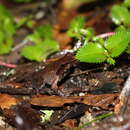en
names in breadcrumbs


The glandular horned toad, or Jingdong spadefoot toad (Xenophrys glandulosa) is a megophryid frog recently described from montane forests at elevations of 1900–2100 m in western Yunnan, southwestern China.It has also been reported in northeastern India, eastern Bhutan, and northern Kachin state, Myanmar.Its common name comes from its type locality, Wuliang Shan, Jingdong, Yunnan Province.Jingdong spadefoot toads live in slow, clear streams that have rocky bottoms and bushy/grassy vegetation along the banks.
Male Jingdong spadefoot toads measure about 78 mm in snout vent length; females are larger at about 87 mm.They are dark brown or grey brown with varying patterning on their back. Rough dorsal warts on the side of their body stand out with bright yellow coloring, but their backs have smooth skin. Their hind legs have dark stripes.They have a black spot between the eyes, and a yellow/white stripe on their upper lip.On the underside, X. glandulosa are yellow-white in color with scattered dark spotting.
In March and April, Jingdong spadefoot toads begin calling a continuous “xia, xia, xia” in afternoons with a crescendo in evenings.They breed in April, when females have around 1000 milky-yellow eggs (each about 2.3 mm in diameter).
(Frost 2016; Huang et al. 1998)
Xenophrys glandulosa, the glandular horned toad or Jingdong spadefoot toad is a species of amphibian in the family Megophryidae found in Yunnan in China, in Nagaland in northeastern India, and in northern Kachin State, Myanmar.[2] It has recently been reported from Bhutan.[3] Its type locality is Mount Wuliang in Jingdong County, Yunnan.[4] Its natural habitats are tropical moist montane forests and rivers.[1]
Xenophrys glandulosa, the glandular horned toad or Jingdong spadefoot toad is a species of amphibian in the family Megophryidae found in Yunnan in China, in Nagaland in northeastern India, and in northern Kachin State, Myanmar. It has recently been reported from Bhutan. Its type locality is Mount Wuliang in Jingdong County, Yunnan. Its natural habitats are tropical moist montane forests and rivers.